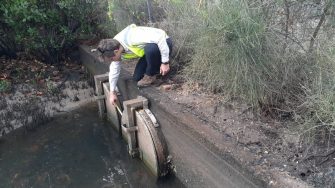
Year: Completed in 2023
UNSW Sydney’s Water Research Laboratory (WRL) is excited to announce the reports and data from the NSW Coastal Floodplain Prioritisation Project are now available: https://www.marine.nsw.gov.au/projects/coastal-floodplain-study.
-
Coastal floodplains are naturally flat, low lying areas surrounding estuaries. Many of these areas have been heavily modified since European settlement. Areas that were once diverse coastal backswamps providing a magnitude of ecosystem services are now drained for agricultural purposes.
Unfortunately, drainage infrastructure in these areas can cause poor water quality, including acid discharges and mass deoxygenation events. The lowest pH WRL engineers have observed in a farm drain is 2.1 – that’s same pH as lemon juice or vinegar!
These floodplains are naturally on low ground, with many areas within 1.5 m of mean sea level. This makes them susceptible to the impacts of sea level rise, which is predicted to increase by up to 1 m throughout the 21st century.
This study provides floodplain and estuary managers with a better understanding of where poor water quality is originating from, as well as assessing the vulnerability of coastal floodplains to sea level rise over the next century. The project reports focus on the Tweed, Richmond, Clarence, Macleay, Hastings, Manning and Shoalhaven estuaries.
-
WRL leveraged our understanding of estuary and floodplain processes to develop a program which included field data collection, numerical modelling and desktop assessments to complete this study.
WRL engineers spent over 20 weeks in the field, collecting primary field data to inform the study. The data we collected includes:
- Acid sulfate soil data across all 7 floodplains
- Measurements of hydraulic conductivity (the speed water moves through soils)
- Key information on floodgate infrastructure within the tidal reaches of the estuaries
- Cross sections of farm drains and creeks
This data is now available for floodplain and estuary managers to use: https://datasets.seed.nsw.gov.au/dataset/coastal-floodplain-prioritisation-study.
WRL then developed a data driven and science-based method to prioritise the parts of the coastal floodplains which:
- Contribute the most to acidic discharges to the estuary
- Have the highest potential to strip oxygen from the estuary
- Have land uses which are most susceptible to impacts from sea level rise
Based on the results, WRL provided a variety of potential management options which recognise the need to balance social, economic and environmental pressures in the face of a changing climate.
The results, as well as the supporting data we collected are now all available to help guide decisions on the future of floodplain management in NSW.
-
In most floodplains, more than 60% of the water quality risks are associated with 2 or 3 subcatchments. Prioritising improved floodplain management in the areas that contribute most to poor water quality has the greatest capacity to deliver sustainable land use practises and environmental benefits.
The geomorphology associated with the highest contributors of acid and low dissolved oxygen blackwater tends to be large, low lying coastal backswamp systems. These are the areas where existing land uses are most likely to be impacted by sea level rise through reduced drainage or sometimes tidal inundation. Proactive and socially aware changes in land management in these areas can assist communities in adapting to sea level rise while also improving the health of the estuaries that are the centre piece of the communities that live around them.
-
- 40% of the over 1,400 floodgates surveyed for this project will be below mean water level once 67 cm of sea level rise occurs (compared to just 5% today).
- There is currently about 3,000 ha below mean water level across the seven floodplains today. This increases to 8,000 ha with 16 cm of sea level rise, and up to 23,000 ha with 67 cm (that’s bigger than some small European countries!)
- WRL engineers dug 180 soil profiles for this project. This was over 370 m of soil profiles dug!
- The lowest pH WRL engineers have observed in a farm drain is 2.1 – that’s same as lemon juice or vinegar!
- Project funding
- Publications
Project funding
The Coastal Floodplain Prioritisation Project was funded by the NSW Government under the Marine Estate Management Strategy. The 10-year Strategy aims to deliver the NSW Government’s broad vision for the marine estate: A healthy coast and sea, managed for the greatest wellbeing of the community, now and into the future. For more information about the NSW Marine Estate visit: www.marine.nsw.gov.au.

